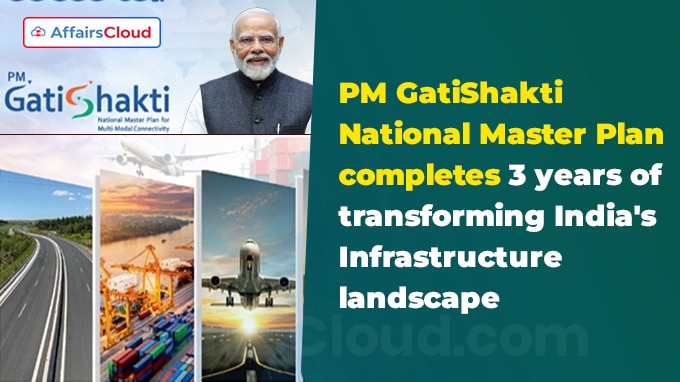 On 13th October 2024, PM Gati Shakti–National Master Plan (NMP) for multi-modal connectivity successfully completed 3 years of implementation and achieved significant milestones in transforming the country’s infrastructure landscape.
On 13th October 2024, PM Gati Shakti–National Master Plan (NMP) for multi-modal connectivity successfully completed 3 years of implementation and achieved significant milestones in transforming the country’s infrastructure landscape.
- It was launched on 13th October, 2021 by Prime Minister (PM) Narendra Modi at Pragati Maidan in New Delhi(Delhi).
- It is being implemented by the Logistics division of Ministry of Commerce & Industry (MoC&I).
About PM Gati Shakti NMP:
i.It is a “Whole-of- Government ” approach aimed to facilitate integrated planning of multimodal infrastructure through collaboration among the concerned ministries. It was launched with the budget outlay of Rs 100 lakh crore.
ii.The initiative aims to ensure seamless and efficient connectivity for the movement of people, goods, and services across different modes of transport, thereby improving last-mile connectivity and reducing travel time.
iii.It was developed as a Digital Master Planning tool by Bhaskaracharya National Institute for Space Applications and Geoinformatics (BISAG-N) and was prepared in dynamic Geographic Information System (GIS) platform wherein data on specific action plan of all ministries/ departments have been incorporated within a comprehensive database.
iv.It is mainly driven by 7 engines such as: roads, airports, mass transport, logistics infrastructure, railways, ports and waterways.
Six Pillars of PM Gati Shakti NMP:
i.Comprehensiveness: It will integrate all existing/ planned initiatives of various ministries like Bharatmala, Sagarmala, inland waterways, dry or land ports, among others.
ii.Synchronization: It will provide visibility and coordination in planning and implementation of projects of individual departments or ministries.
iii.Analytical: It will provide the whole data at one place with GIS based spatial planning and analytical tools.
iv.Prioritization: It will enable different departments to prioritize their projects through cross-sectoral interactions.
v.Dynamic: It will help different ministries and departments to identify the important interventions for enhancing and updating
vi.Optimization: It will assist various ministries in planning for expansion of new projects following the identification of critical gaps.
Key Targets to be achieved in 2025:
i.The Ministry of Roads, Transport and Highways (MoRTH) aims to build 2 lakh kilometers (kms) long of National Highway (NH) in the country.
ii.The Ministry of Civil Aviation (MoCA) aims to construct a total 220 airports/helicopters/aerodromes in the country.
iii.The Ministry of Petroleum and Natural Gas (MoP&NG) aims to build 34,500 kms long pipeline in the country.
iv.The Ministry of Renewable Energy (MoRE) aims to increase renewable energy capacity to 225 GigaWatt (GW).
v.The Ministry of Railways (MoR) has set the target to achieve 1,600 million tonnes (MT) of cargo capacity in the country.
vi.Ministry of Power (MoP) plans to build over 4.54 lakh circuit kms of transmission networks in India.
vii.The Department of Telecommunications (DoT) plans to connect 2.6 lakh gram panchayats.
viii.The Ministry of Ports, Shipping and Waterways (MoPS&W) has set the target to achieve 1,750 Metric Million Tonnes Per Annum (MMTPA) of cargo capacity.
Key Progress:
i.On boarding whole of the Government on a unified platform: So far, 208 big-ticket infrastructure projects worth Rs 15.39 crores have been examined by the Networking Planning Group (NPG) based on the basic principles of PM Gati Shakti like: integrated planning and development of multimodal infrastructure, last-mile connectivity to economic and social nodes, among others.
- The PM Gati Shakti NMP has onboarded 44 Central Ministries and 36 States/Union Territories (UTs), and a total of 1,614 data layers have also been integrated.
ii.PM Gati Shakti SMPs Portal: All 36 states and UTs have developed their respective PM Gati Shakti State Master Plans (SMPs) portals which are in line with the PM Gati Shakti NMP platform to streamline infrastructure assets and enhance regional development. More than 533 projects have been mapped by states/UTs on the PM Gati Shakti platform.
iii.EXIM and Trade Facilitation: The PM Gati Shakti initiative which is aligned with the National Logistics Policy (NLP) has played a pivotal role in addressing critical infrastructure gaps, reducing logistics costs, and improving logistics performance of India.
- According to the World Bank’s “Logistics Performance Index” report released in 2023, India’s has improved its ranking by 6 places i.e. from 44th spot (in 2018) to 38th (in 2023).
- For tracking and tracing 100% of India’s containerized EXIM cargo, the Logistics Data Bank (LDB), has been developed. LDB uses RFID technology through the Internet of Things (IoT), Big Data and Cloud-based solutions to provide real-time tracking of EXIM container movement in India.
iv.Regional Workshops and Stakeholder Engagement: Since the launch of PM Gati Shakti NMP, 5 regional workshops have been conducted across all 36 states/UTs to provide knowledge sharing, best practices, and project demonstration by central and state governments.
v.Promoting Sustainable, Data-driven development: PM Gati Shakti initiative is based on data driven-approach, powered by GIS based tools and a real time monitoring system that enables faster and more informed decision-making. Thus, it will help India to achieve the target of Net Zero by 2070 as platform promotes the use of green infrastructure and sustainable logistics solutions.
vi.Extending PMGS to the Districts: A District Master Plan (DMP) platform is being developed with the technical support of BISAG-N, to extend PM Gati Shakti (PMGS) to the district level.
- This portal will help district authorities in collaborative planning, identifying infrastructure gaps and scheme implementation.
- Currently, a beta version of the portal has already been developed for 28 aspirational districts and user accounts were provided to these districts on 18th September, 2024.
The DMP portals for all districts of the country will be developed in a phased manner and is expected to be completed by 31st March, 2025.
vii.Training and Capacity Building: DPIIT has been entrusted with the responsibility to train officials to build their capacities. At present, a course on the PMGS is available on the iGoT platform and has already been completed by more than 2,000 officials.
- Also, all Central Training Institutions (CTIs) have integrated a course module on the PM Gati Shakti into their regular officers’ training curriculum.
Key Accomplishments of various Ministries/ States/UTs under PM Gati Shakti NMP:
i.The MoRTH planned more than 8,891 kilometer (km) of roads to be developed using NMP.
- The Ministry of Railways (MoR) used NMP to plan over 27,000 km of railway lines. It has also accelerated the completion of Final Location Surveys (FLS) as it has completed 449 FLS in Financial Year 2021-22 (FY22) compared to 57 FLS in FY21.
ii.The MoP&NG synchronized the process for Detail Route Survey (DRS) which has reduced the time required to create a report from 6 to 9 months to just one day using electronic DRS (eDRS).
iii.A 13 GigaWatt (GW) renewable energy project from Leh (UT Ladakh) to Kaithal (Haryana) achieved optimal alignment of the “Green Energy Corridor” for inter-state transmission.
iv.The Government of Uttar Pradesh (UP) developed the SMP portal to identify locations for new schools in underserved areas through the Pahunch portal.
- Goa used the NMP platform to develop a disaster management plan for flood-prone areas along the Amona River.
- Gujarat planned its 300 km coastal corridor using NMP, which reduced the number of No Objection Certificate (NOC) permissions required for clearance from 28 to 13.
v.The Department of School Education and Literacy (DoSEL) under the Ministry of Education (MoE) used the NMP portal to link Pradhan Mantri Schools for Rising India (PM-SHRI) schools with local industries for district-specific skill training.
vi.The Ministry of Rural Development (MoR) integrated schemes such as Pradhan Mantri Grameen Sadak Yojana (PMGSY) and Pradhan Mantri Awas Yojana- Grameen (PMAY-G) to improve asset planning and implementation.
vii.The Ministry of Tribal Affairs (MoTA) identified infrastructure gaps for Particularly Vulnerable Tribal Groups (PVTGs) utilizing the PM Jan Man portal.
Key Initiatives under PM Gati Shakti NMP:
National Logistics Policy:
i.It was launched on 17th September 2022, with the objective of reducing logistics costs, improving India’s Logistics Performance Index (LPI) ranking to be among 25 countries by 2030, and encouraging data-driven decision making.
ii.The implementation of NLP is driven by the Comprehensive Logistics Action Plan (CLAP), which focuses on different areas like: digital logistics systems, asset standardization human resource development, among others.
iii.The NLP in collaboration with Capacity Building Commission (CBC) has developed training modules which are integrated with central and administrative training institutes through webinars, workshops, and digital platforms.
iv.At present, 26 states and UTs have aligned with the NLP by notifying their respective State Logistics Policies (SLPs).
v.Unified Logistics Integrated Platform (ULIP) has integrated 33 logistics-related systems across 10 ministries, boosting innovation. At present, more than 930 private companies are registered with ULIP, with 95 applications (apps) made live and 185 companies signing Non-Disclosure Agreements (NDAs).
Gati Shakti Sanchar Portal:
i.It was launched on 14th May 2022 by Union Minister Ashwini Vaishnav, Ministry of Electronics and Information Technology (MeitY), for centralised Right of Way (RoW) approvals.
ii.The primary objective of the portal is to provide universal and equitable access to broadband services across the country especially in the rural areas.
iii.The portal was developed by Bhopal (Madhya Pradesh, MP)-based MP State Electronics Development Corporation (MPSEDC) on behalf of DoT.
iv.It enables applicants such as Telecom Service Providers (TSPs)/ Infrastructure Providers (IPs)/ Internet Service Providers (ISPs) to apply for RoW approvals.
- As on 11th October 2024, 2.11 lakh applications for RoW have been approved.
v.The portal is integrated with all 36 states/UTs and with various central ministries like: MoRTH, MoR, Ministry of Defence (MoD) and Ministry of Environment, Forest and Climate Change (MoEFCC).
Other Key Points:
i.On 1st October 2022, 5G services were launched in India. So far, over 13 crore subscribers have begun to use 5G services, thus making India the fastest roll-out of 5G services anywhere in the world.
ii.The Government of India (GoI) has sanctioned the proposal to set up 41,160 mobile towers in the country with a budget outlay of Rs 41,331 crore, to provide 4G connectivity to about 55,000 villages.
- Also, GoI has expanded the scope of BharatNet program to connect all inhabited villages with a budget outlay of Rs 1.88 lakh crore.
About Ministry of Commerce and Industry (MoCI):
Union Minister- Piyush Goyal (Constituency- Mumbai North, Maharashtra)
Minister of State (MoS)- Jitin Prasada (Constituency- Pilibhit, Uttar Pradesh, UP)




